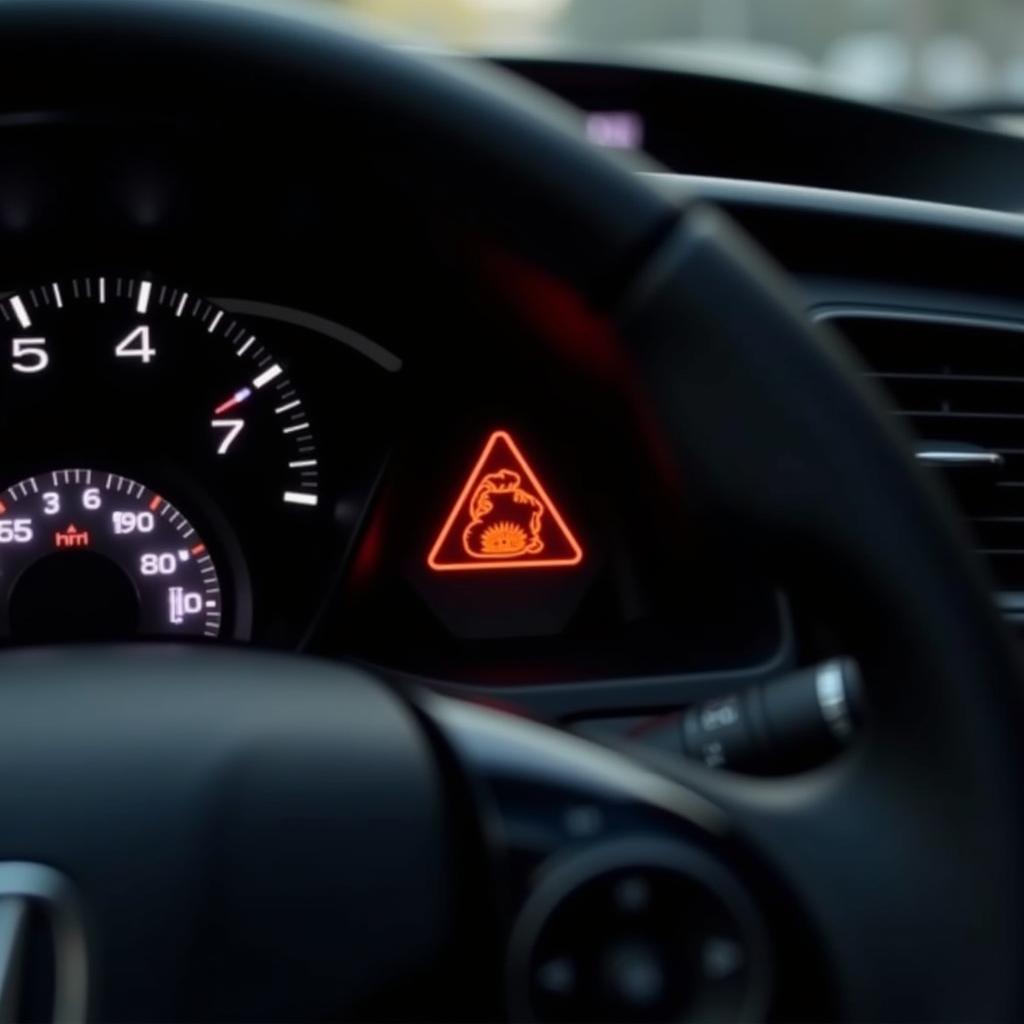Owning a 2010 Honda Civic comes with its perks, but like any vehicle, it can have its quirks. One such issue that might arise is the dreaded airbag light flashing on your dashboard. While a car detail might seem unrelated, understanding the potential causes of this warning light can save you time, money, and potentially ensure your safety.
 2010 Honda Civic dashboard with airbag light illuminated
2010 Honda Civic dashboard with airbag light illuminated
Common Culprits Behind the Glowing Airbag Light
An illuminated airbag light doesn’t automatically mean your airbag will deploy unexpectedly. It signals a fault within the Supplemental Restraint System (SRS), which encompasses the airbags, seatbelt pretensioners, crash sensors, and the control module. Let’s delve into some common reasons why your 2010 Honda Civic’s airbag light might be on:
-
Loose or Faulty Wiring: The most frequent offender is loose or corroded wiring beneath the seats. This can occur due to regular adjustments, moving heavy objects, or even spilled liquids.
-
Seat Belt Buckle Sensor Malfunction: The sensors in your seatbelt buckles, responsible for detecting if your seatbelt is fastened, can malfunction, triggering the airbag light.
-
Faulty Clock Spring: The clock spring, located within the steering wheel, allows electrical connections between the airbag system and steering wheel components. If it wears out or breaks, it disrupts the airbag circuit.
-
Depleted Battery or Electrical Issues: A weak car battery or electrical fluctuations can affect the sensitive SRS system, causing the light to come on.
-
Faulty Airbag Control Module: The airbag control module is the brain of the system. If it encounters a fault, it stores a diagnostic code and illuminates the warning light.
-
Aftermarket Accessories: Installing aftermarket accessories, especially those interfering with the steering wheel, seats, or wiring harness, can inadvertently disrupt the airbag system.
Addressing the Airbag Light: From Diagnosis to Resolution
Ignoring an airbag light isn’t a risk you want to take. It’s crucial to have the system diagnosed and repaired promptly.
-
Diagnostic Trouble Codes (DTCs): A professional mechanic can use a specialized scan tool to retrieve Diagnostic Trouble Codes (DTCs) stored in your car’s computer. These codes pinpoint the specific area of the SRS requiring attention.
-
Inspection: After retrieving the DTCs, a visual inspection of the wiring, connectors, and components associated with the fault code is crucial. This might involve checking under the seats, inspecting the seatbelt buckles, and examining the clock spring.
-
Component Testing: Based on the inspection and DTCs, the mechanic tests individual components like sensors and modules to determine their functionality.
-
Repair or Replacement: Once the faulty component is identified, it’s either repaired or replaced. This could involve anything from re-securing loose wiring to replacing a faulty sensor or module.
-
System Reset: After repairs, the mechanic uses the scan tool to clear the fault codes and reset the airbag system.
The Car Detailing Connection: Prevention is Key
While a car detail won’t fix a faulty airbag sensor, a meticulous interior detail can play a preventative role:
-
Thorough Cleaning: Detailers can remove dirt, debris, and spilled liquids that accumulate under the seats, potentially affecting wiring and sensors.
-
Conditioning and Protecting: Applying conditioners to leather surfaces and protectants to vinyl and plastic parts can prevent premature wear and tear, helping maintain the integrity of components like seatbelt buckles and wiring insulation.
“Regular car detailing, particularly meticulous interior cleaning, is more than just about aesthetics. It can help prevent issues with sensitive electronic systems like the airbag system, ensuring your safety on the road.” – John Bennet, Senior Automotive Electrician, CarDetailingUK
 Car detailing professional cleaning the interior of a 2010 Honda Civic
Car detailing professional cleaning the interior of a 2010 Honda Civic
Don’t Ignore the Warning: Prioritize Safety
The airbag light in your 2010 Honda Civic serves as a crucial safety reminder. Ignoring it can be risky. By understanding its potential causes and taking prompt action, you can address the issue effectively, ensuring your safety and the optimal functioning of your vehicle’s safety features.
FAQs
1. Can I drive my car with the airbag light on?
While your car might drive, it’s strongly advised against driving with the airbag light on. The system might not deploy in an accident, compromising your safety.
2. How much does it cost to fix an airbag light issue?
The cost can range from a simple wiring fix (under $100) to replacing a faulty module (several hundred dollars).
3. Can I fix the airbag light myself?
The airbag system is complex. It’s best to leave diagnosis and repair to qualified mechanics.
4. Will disconnecting the battery reset the airbag light?
Disconnecting the battery might temporarily reset the light but won’t address the underlying issue.
5. How often should I have my car’s airbag system checked?
It’s good practice to have the airbag system inspected annually or as part of a comprehensive vehicle check-up.
If you have any other questions or need assistance with your car’s airbag system, feel free to reach out to our expert team. You can contact us through WhatsApp: +1(641)206-8880 or email us at [email protected]. We’re available 24/7 to provide you with the best possible support and guidance.

Leave a Reply